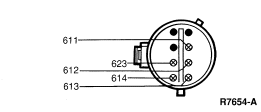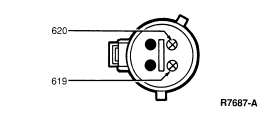Section 01-20B: Restraints, Passive—Supplemental Air Bag System | 1993 Mustang Workshop Manual |
DISPOSAL PROCEDURES
Air Bag Disposal
Procedure 1
Electronic Deployment with Intact Wiring
This procedure is to be used in the event that a vehicle with a live air
bag inflator is to be scrapped. Scrapping a vehicle may be required due to
severe damage in a non-air bag deployable accident or at the end of the
vehicle's useful life. This procedure assumes that the air bag wiring remains
intact; that is, no diagnostic trouble codes are indicated by the readiness
indicator, the system proves out correctly and the vehicle's battery is still
in place (or one has been provided). This procedure is to be performed
outdoors,away from other personnel, since the deploying air bag makes a loud
report upon actuation.
- Check and clear the front seat of all loose objects.
- Do not permit any occupants to remain inside the vehicle.
- Open the hood and check for an operational vehicle battery. If no battery
is found, supply one and connect it in the usual manner.
- Turn the ignition switch to the RUN position and observe the air bag
readiness indicator. If the indicator illuminates for six seconds and then
stops, the system is intact and may be deployed. Continue with Procedure 1. If
a series of diagnostic trouble codes appear, go to Procedure 2 to deploy the
unit.
- Turn ignition to the OFF position.
- Remove LH quarter trim panel. Refer to Section 01-05.
- Disconnect rear air bag sensor connector. Using a 152mm (6 inch) length of
wire, jump Circuits 614 (GY/O) and 611 (W/O) of the harness connector.

- Locate center crash sensor at top center of radiator support and disconnect.
 WARNING: BE SURE NO OCCUPANTS ARE INSIDE THE VEHICLE.
WARNING: BE SURE NO OCCUPANTS ARE INSIDE THE VEHICLE.
- Again, ensure no occupants are inside the vehicle. Locate the 619 (PK/W)
wire at the harness connector. Using a length of wire short, Circuit 619 (PK/W)
to ground.

- If successful, a loud report will be heard and the bag material will be
visible in the center of the steering wheel. Allow at least 10 minutes before
approaching the air bag to allow for cooling.
The air bag is now inoperative and the vehicle may be scrapped in the
usual manner. If the air bag did not deploy, continue to Procedure 2.
Procedure 2
Remote Deployment of Air Bag
This procedure is to be used in the event that a vehicle with a live air
bag is to be scrapped, but the vehicle does not contain an intact wiring
harness or certain system components are inoperative. This procedure can also
be used if Procedure 1 was unsuccessful.
 WARNING: REMOTE DEPLOYMENT IS TO BE PERFORMED OUTDOORS WITH ALL PERSONNEL AT
LEAST 20 FEET AWAY TO ENSURE PERSONAL SAFETY AND DUE TO THE LOUD REPORT WHICH
OCCURS WHEN AN AIR BAG IS DEPLOYED.
WARNING: REMOTE DEPLOYMENT IS TO BE PERFORMED OUTDOORS WITH ALL PERSONNEL AT
LEAST 20 FEET AWAY TO ENSURE PERSONAL SAFETY AND DUE TO THE LOUD REPORT WHICH
OCCURS WHEN AN AIR BAG IS DEPLOYED.
- Remove the driver air bag from the steering wheel as outlined.
- Cut the two air bag connector wires and strip 25mm (1 inch) of insulation
from the ends. Obtain two wires at least 20 feet long. Connect one end of each
wire to each of the air bag module wires.
- Place the air bag with the trim cover facing upward on a flat surface in a
remote area such as a parking lot or field.
 WARNING: DO NOT PLACE THE AIR BAG WITH THE TRIM COVER FACING DOWN, AS THE
FORCES OF THE DEPLOYING AIR BAG MAY CAUSE IT TO RICOCHET AND CAUSE PERSONAL
INJURY.
WARNING: DO NOT PLACE THE AIR BAG WITH THE TRIM COVER FACING DOWN, AS THE
FORCES OF THE DEPLOYING AIR BAG MAY CAUSE IT TO RICOCHET AND CAUSE PERSONAL
INJURY.
- Remaining at least 20 feet away from the air bag, deploy the air bag by
touching the other ends of the two wires to the terminals of a 12-volt vehicle
battery.
- If successful, a loud report will be heard and the air bag material will be
visible. Allow at least 10 minutes before approaching the air bag to allow for
cooling.
The driver air bag is now deployed and may be scrapped in accordance with
scrap metal procedures.


 WARNING: BE SURE NO OCCUPANTS ARE INSIDE THE VEHICLE.
WARNING: BE SURE NO OCCUPANTS ARE INSIDE THE VEHICLE. 
 WARNING: REMOTE DEPLOYMENT IS TO BE PERFORMED OUTDOORS WITH ALL PERSONNEL AT
LEAST 20 FEET AWAY TO ENSURE PERSONAL SAFETY AND DUE TO THE LOUD REPORT WHICH
OCCURS WHEN AN AIR BAG IS DEPLOYED.
WARNING: REMOTE DEPLOYMENT IS TO BE PERFORMED OUTDOORS WITH ALL PERSONNEL AT
LEAST 20 FEET AWAY TO ENSURE PERSONAL SAFETY AND DUE TO THE LOUD REPORT WHICH
OCCURS WHEN AN AIR BAG IS DEPLOYED.  WARNING: DO NOT PLACE THE AIR BAG WITH THE TRIM COVER FACING DOWN, AS THE
FORCES OF THE DEPLOYING AIR BAG MAY CAUSE IT TO RICOCHET AND CAUSE PERSONAL
INJURY.
WARNING: DO NOT PLACE THE AIR BAG WITH THE TRIM COVER FACING DOWN, AS THE
FORCES OF THE DEPLOYING AIR BAG MAY CAUSE IT TO RICOCHET AND CAUSE PERSONAL
INJURY.